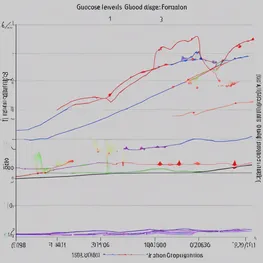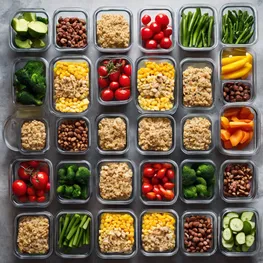Table of contents
- The Impact of Glycemic Load on Blood Sugar Levels
- Top Low Glycemic Load Foods for Healthy Eating
- Top 10 High Glycemic Load Foods
- How Glycemic Load Impacts Diabetes Control
- Mastering Lifestyle Modifications for Optimal Blood Sugar Levels
- Final Thoughts
In this article, we will delve into the fascinating world of glycemic load and how it impacts our health. Understanding the glycemic load of foods is crucial for maintaining stable blood sugar levels and making informed dietary choices. Join us as we uncover the secrets behind this concept and its significance in maintaining a balanced and healthy lifestyle.
The Impact of Glycemic Load on Blood Sugar Levels
Glycemic load measures the overall impact of a food on blood sugar levels by taking into account both the quantity and quality of carbohydrates. It differs from glycemic index, which only considers the quality of carbohydrates.
Top Low Glycemic Load Foods for Healthy Eating
When it comes to healthy eating, choosing foods with a low glycemic load can have numerous benefits for your overall well-being. Here are some examples of such foods and why they are beneficial:
- Leafy green vegetables: Vegetables like spinach, kale, and broccoli have a low glycemic load because they are high in fiber and have a minimal impact on blood sugar levels. They are also packed with essential nutrients, vitamins, and minerals that support good health.
- Legumes: Foods like lentils, chickpeas, and black beans have a low glycemic load due to their high fiber content. They provide a steady release of energy, promote gut health, and help in maintaining stable blood sugar levels.
- Whole grains: Whole grains such as quinoa, oatmeal, and brown rice have a low glycemic load because they contain complex carbohydrates that are digested slower, leading to a gradual release of glucose into the bloodstream. They are also rich in fiber and other important nutrients.
- Berries: Berries like strawberries, blueberries, and raspberries have a low glycemic load thanks to their high fiber content and low sugar content. They are packed with antioxidants, vitamins, and minerals that support heart health, brain function, and immune system.
- Nuts and seeds: Foods like almonds, walnuts, chia seeds, and flaxseeds have a low glycemic load due to their high fiber, healthy fats, and protein content. They provide lasting energy, support weight management, and contribute to overall heart health.
- Fatty fish: Fatty fish like salmon, mackerel, and sardines have a low glycemic load and are rich in omega-3 fatty acids, which are beneficial for heart health, brain function, and reducing inflammation.
- Avocado: Avocado has a low glycemic load and is rich in healthy fats and fiber. It provides numerous health benefits, including improved digestion, reduced inflammation, and support for heart health.
- Plain Greek yogurt: Plain Greek yogurt has a low glycemic load and is an excellent source of protein, calcium, and probiotics. It helps in maintaining stable blood sugar levels, supports gut health, and contributes to muscle repair and growth.
- Eggs: Eggs have a low glycemic load and are packed with high-quality protein, healthy fats, vitamins, and minerals. They provide long-lasting energy, support satiety, and help in maintaining stable blood sugar levels.
- Herbs and spices: Herbs and spices like cinnamon, turmeric, and ginger have a low glycemic load and offer numerous health benefits, including improved insulin sensitivity, reduced inflammation, and enhanced digestion.
Top 10 High Glycemic Load Foods
Foods with a high glycemic load, such as white bread, white rice, and sugary cereals, should be consumed sparingly. These foods cause a rapid spike in blood sugar levels, leading to an increase in insulin production. Over time, this can contribute to insulin resistance and the development of type 2 diabetes. High glycemic load foods also promote weight gain and can increase the risk of heart disease. To maintain stable blood sugar levels, it is advisable to choose low glycemic load foods like whole grains, fruits, and vegetables.
How Glycemic Load Impacts Diabetes Control
Understanding and managing glycemic load can be crucial for individuals with diabetes in maintaining optimal blood sugar control. By closely monitoring their glycemic load, individuals can make informed decisions about their diet and lifestyle choices to prevent fluctuations in blood glucose levels and reduce the risk of complications.
-
Definition of Glycemic Load
Glycemic load is a measure that takes into account both the amount of carbohydrates in a food and how quickly it raises blood sugar levels. It provides a more comprehensive understanding of the impact of specific foods on blood glucose levels compared to the glycemic index alone.
-
Stabilizing Blood Sugar Levels
By understanding the glycemic load of different foods, individuals with diabetes can choose low glycemic load foods that have a slower release of glucose into the bloodstream. This helps to prevent spikes and crashes in blood sugar levels, promoting more stable blood glucose control.
-
Managing Insulin Resistance
High glycemic load foods can lead to increased insulin demand and poor insulin sensitivity. By avoiding foods with high glycemic load, individuals can manage insulin resistance more effectively, reducing the strain on the pancreas and improving their body's ability to utilize insulin.
-
Weight Management
Glycemic load can also impact weight management for individuals with diabetes. Foods with high glycemic load tend to be high in calories and can contribute to weight gain. By choosing foods with lower glycemic load, individuals can better control their calorie intake and maintain a healthy weight, which is important for overall diabetes management.
-
Reducing Risk of Complications
Uncontrolled blood sugar levels in diabetes can lead to long-term complications such as heart disease, kidney damage, and nerve damage. Understanding and managing glycemic load can help individuals with diabetes minimize the risk of these complications by promoting better blood sugar control and reducing the likelihood of prolonged high glucose levels.
Mastering Lifestyle Modifications for Optimal Blood Sugar Levels
When it comes to achieving optimal blood sugar levels, it's not just about what we eat. Non-dietary factors can also significantly impact our blood sugar levels and glycemic load. Here are some important factors to consider:
- Physical activity: Regular exercise can help improve insulin sensitivity, allowing the body to better regulate blood sugar levels. It can also lower glycemic load by promoting the use of glucose as fuel.
- Stress levels: High stress levels can lead to increased blood sugar levels as the body releases stress hormones that raise glucose production. Implementing stress management techniques, such as meditation or deep breathing, can help keep blood sugar levels in check.
- Sleep quality: Lack of sleep or poor sleep quality can disrupt hormone regulation, including insulin production and glucose utilization. Prioritizing good sleep hygiene is crucial for maintaining stable blood sugar levels.
- Medication and medical conditions: Certain medications, such as corticosteroids or beta-blockers, can affect blood sugar levels. Additionally, medical conditions like hormonal imbalances or infections can impact glucose control.
- Alcohol consumption: Alcohol can interfere with liver function, leading to fluctuating blood sugar levels. It's essential to consume alcohol in moderation and monitor blood sugar levels when drinking.
- Hydration: Dehydration can cause blood sugar levels to rise. Staying adequately hydrated is crucial for proper glucose regulation.
- Environmental factors: Extreme temperatures, such as hot weather or cold conditions, can affect how the body processes and regulates blood sugar. Being mindful of these factors and adapting accordingly is important for blood sugar control.
Final Thoughts
Understanding glycemic load is essential for effective blood sugar management. By comprehending the concept of glycemic load, individuals can make informed dietary choices that help regulate their blood sugar levels and promote overall health.
-
Balancing Blood Sugar Levels
Glycemic load provides a more accurate measure of how specific foods impact blood sugar levels compared to the glycemic index. By choosing foods with a low glycemic load, individuals can prevent drastic spikes and drops in blood sugar, ensuring a more stable and controlled level throughout the day.
-
Weight Management
Understanding glycemic load can be beneficial for weight management. Foods with a high glycemic load tend to be quickly digested, leading to a rapid release of glucose into the bloodstream. This can cause insulin spikes and subsequent fat storage. By opting for foods with a lower glycemic load, individuals can better control their appetite, reduce cravings, and maintain a healthy weight.
-
Reducing the Risk of Chronic Diseases
A diet high in foods with a high glycemic load has been associated with an increased risk of chronic conditions such as obesity, diabetes, and heart disease. By understanding glycemic load and selecting foods that have a lower impact on blood sugar, individuals can help reduce their risk of developing these health conditions and promote long-term well-being.
-
Sustained Energy Levels
Foods with a low glycemic load provide a steady release of glucose into the bloodstream, leading to sustained energy levels. This can prevent energy crashes and fatigue, promoting better focus, productivity, and overall physical performance.
-
Meal Planning and Food Choices
Having knowledge about glycemic load allows individuals to plan meals and make food choices that support stable blood sugar levels. By incorporating a variety of low glycemic load foods, such as whole grains, lean proteins, fruits, and vegetables, individuals can design balanced and nutritious meals that optimize blood sugar management.
In conclusion, understanding the glycemic load of foods is essential for maintaining a healthy diet and managing blood sugar levels. By knowing which foods have a low glycemic load, individuals can make informed choices to prevent spikes in their blood glucose levels. This knowledge is especially crucial for those with diabetes or anyone looking to improve their overall health. With a better understanding of the glycemic load of foods, individuals can make smarter food choices and lead a more balanced and healthier lifestyle.
Frequently asked questions related to understanding the glycemic load of foods
What is the glycemic load of a food?
The glycemic load of a food is a measure of how much it raises blood sugar levels after consumption.
What is the difference between glycemic load and glycemic index?
Glycemic load takes into account both the quality and quantity of carbohydrates in a food, whereas glycemic index only considers the quality of carbohydrates.
What are high glycemic load foods?
High glycemic load foods have a score of 20 or more. These include refined grains, sugary drinks, processed snacks, and desserts.
How can I reduce the glycemic load of my meals?
You can reduce the glycemic load of your meals by choosing low glycemic load foods, incorporating protein and healthy fats, and avoiding refined and processed carbohydrates.
Is the glycemic load the same for everyone?
The glycemic load can vary depending on factors like individual metabolism, cooking methods, and food combinations.
How is the glycemic load calculated?
The glycemic load is calculated by multiplying the glycemic index of a food by its carbohydrate content and dividing by 100.
Why is it important to understand the glycemic load of foods?
Understanding the glycemic load of foods can help with managing blood sugar levels, weight control, and preventing chronic diseases like diabetes and heart disease.
What are low glycemic load foods?
Low glycemic load foods have a score of 10 or less. These include non-starchy vegetables, fruits, whole grains, legumes, and nuts.







